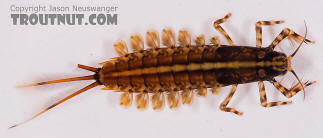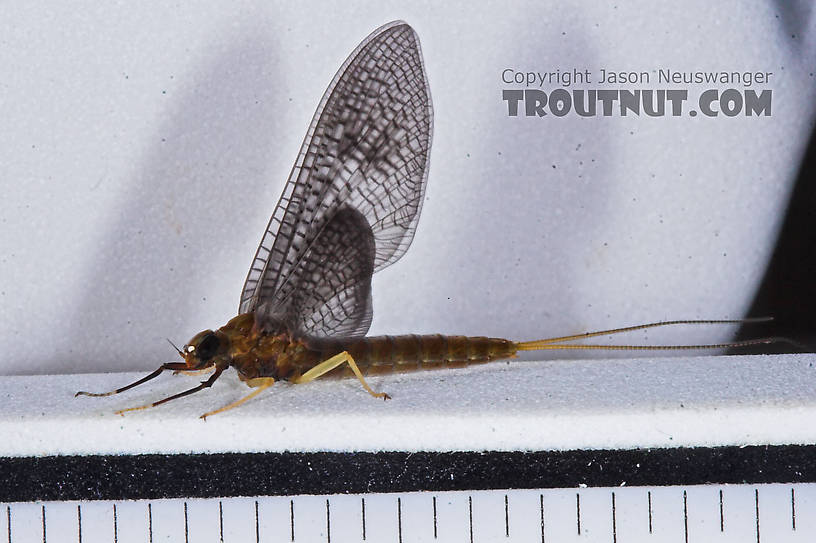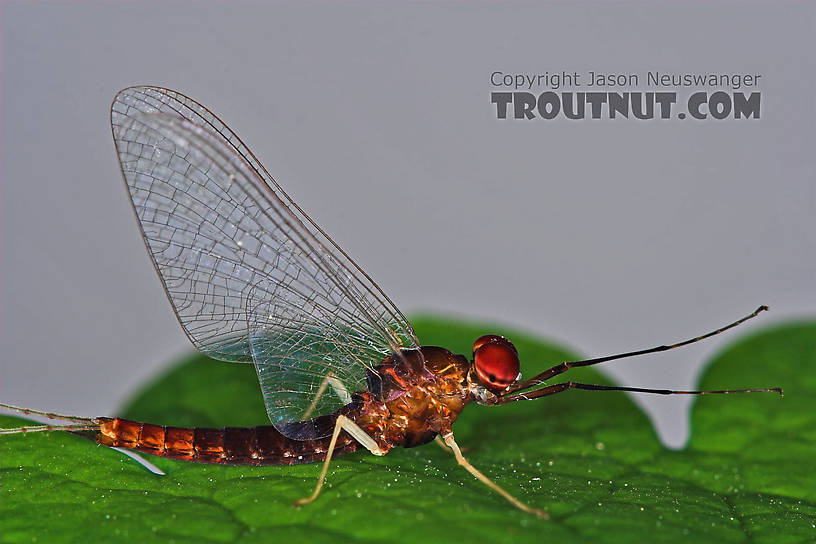Reproduction and Life Cycle
The Shortest-Life Award Goes to...
Twenty-four hours. Add or subtract a few, and you have the
entire lifespan of an Isonychia bicolor mayfly. Now we
revisit the question that was presented in the introduction to
this site, and again we think: just how would we spent
such a short time frame if it were all we were given? Read on to
find out how this insect uses the hours it has to maximum
potential, carrying out what seems should take longer than the
mere eye-blink of time that it does. For the mayfly, there are
three main stages of life: egg, larvae, and adult (no pupal
stage), naming this life cycle hemimetabolous.
The organism spends approximately 99 percent of its lifetime
working its way to maturity, leaving less than 1 percent -- the
equivalent of a few minutes to an hour-- of its life to live as
a free-flying, full-grown mayfly (DeWalt et al. 2010, Neuswanger
2012).
Isonychia bicolor:
A Rare Bivoltine Species
There are two major reproductive peaks of the year
for Isonychia bicolor, making this the only
identified bivoltine (semiannual, or twice per year,
generation) mayfly species. Although the exact times
of year do vary according to the local/regional
climate and temperature, as well as the weather
trends experienced in any given year, these
fecundity (reproduction) patterns are consistent
enough to be recognizable:
~ The first, or "main" cohort emerges in the late winter to
early spring. This generation is called "sadleri" or
"christina" by some scientists in the field, and
they tend to be the larger cohort, growing to about
15-18 millimeters in length. In addition to their
size, the early batch tends to be larger in number,
sometimes doubling that of the later, "secondary"
ones born in the fall (Echols et al. 2010,
Kondratieff and Voshell 1984).
~ The second cohort, whose hatching begins in the late summer
and continues throughout September, October and
sometimes into November, are commonly called the "harperi"
and more specifically the "matilda" or "circe,"
depending on whether they are colored darkly or with
skin that is light and pale. Individuals of this
variety tend to reach 10-13 mm (Kondratieff and
Voshell 1984).
An evolutionary advantage of this virtually
year-round existence is the unique filtering habits
that come as a beneficial by-product of this
species' feeding habits. So long as there is a river
rushing with both water and life, it is going to
yield more survival and success if it is cleaned
periodically by the species who does it best. Since
Isonychia bicolor is one of only four North
American mayfly genera that does this, it proves
itself a good neighbor to have around--throughout
the changing seasons of the year (Echols et al.
2010).
The bivoltine life pattern is unique in that it is a
slight variation of the more common seasonal-multivoltine-summer
life history. This is one of the three prominent
patterns (along with seasonal-univoltine-winter and
non-seasonal-multivoltine") that are most often seen
in mayflies and some other insects (Jacobi and Benke
1991). For more on what distinguishes Isonychia
bicolor from others in the animal kingdom, see
Classification.
An example of locomotion in Isonychia
bicolor nymphs. Video courtesy of Jason Neuswanger
at Troutnut.com (Isonychia bicolor species
homepage), via Youtube.com.
If you would like to view this video in its original
context,
click here.
To view this video on Youtube,
click here.
The Stages Within the
Phases
The presence of this aquatic insect
cleaning the waters at nearly every time of year is
a miraculous thing. Despite their being sensitive to
subtle changes in a number of conditions (e.g. pH,
temperature, etc.), they can also be considered a
'toughened' species--that is, they may be particular
about where they live, but they have 'learned'
(evolutionary, as a species on the whole) to survive
in these habitats in their many facets of
Despite their being sensitive to
subtle changes in a number of conditions (e.g. pH,
temperature, etc.), they can also be considered a
'toughened' species--that is, they may be particular
about where they live, but they have 'learned'
(evolutionary, as a species on the whole) to survive
in these habitats in their many facets of seasonal
change which may potentially impact survival--and
'learned' it well (Kondratieff and Voshell 1984).
This explains why they are able to carry out their
functions dutifully throughout the year,
concentrated in the two peaks as described above.
seasonal
change which may potentially impact survival--and
'learned' it well (Kondratieff and Voshell 1984).
This explains why they are able to carry out their
functions dutifully throughout the year,
concentrated in the two peaks as described above.
However, we must remember that their time is
limited; they only have a day to live. Here is how
they generally spend that time:
~Once hatched from their eggs (this
happens fairly quickly upon oviposition,
in which a female lays, or deposits, the eggs on the surface of
highwater areas), the young organism crawls onto land to walk.
It has officially entered the bulk of its life, the larval
stage. At this point they are called "nymphs."
The larva form of the insect resides in the same habitat as its
adult or 'parent' form but is smaller, lacks genitalia, is more
fragile overall, and possesses tiny "wing-pads" as a precursor
to fully-developed wings to come (DeWalt et al. 2010).
the insect resides in the same habitat as its
adult or 'parent' form but is smaller, lacks genitalia, is more
fragile overall, and possesses tiny "wing-pads" as a precursor
to fully-developed wings to come (DeWalt et al. 2010).
*The first winged stage is thelarval
subimagostage. In trout
fisherman jargon, an individual at this stage is called, simply,
a "dun." Their wings are cloudy, delicate, and covered in
microtrichia: microscopic hairs
which allow them to quickly escape water, though their new wings
tend to hold their light bodies back, making them prime targets
for hungry fish (DeWalt et al. 2010).

*A matter of hours to a day later, nymphs molt into the second
winged form: the sexually mature imago,
or "spinner," stage. Most will progress to this stage. Some
females, however, do not (DeWalt et al. 2010).
Mating: Completing the Mayfly 'Bucket List'
Toward the end of the day and the end of their short
lives, Isonychia bicolor adults "mate
in swarms 20-30 feet in the air, and the females drop their eggs
from high above the water before they join...males in falling"
to the water's surface, "spent" (exhausted). In this condition,
they lay flat, outspreading their wings onto the water, and rest
in "white-gloved howdy" position until their lives eventually,
naturally, and peacefully end (Neuswanger 2012). Soon, the new
generation will awaken, and the cycle begins again.
*To return to the website Table of Contents,
or for more information on the common names listed
just below the header of this page, go
Home.